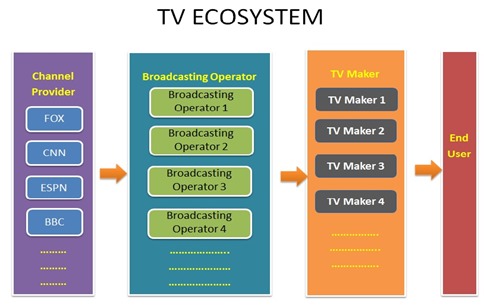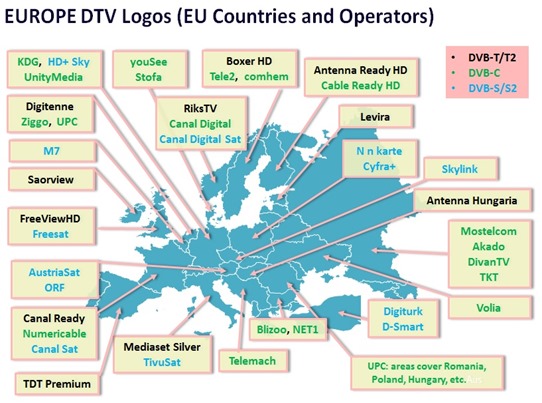Turn on your HDTV to watch a sports program, as if you were actually in the match. A diverse range of programs, from NBA (National Basketball Association), UEFA (The Union of European Football Associations) Champions League, to NPB (Nippon Professional Baseball), offer more entertainment choices for end users. It seems nothing special when talking about this recreation activity-watching TV. None the less, there is a force behind the screen driven by accumulated innovation and technology integration within the TV industry. From analog to digital signal eras, TV makers and system operators have ceaselessly developed next generation specifications via a series of standard compliance certifications to ensure AV quality for end-users.
With several years experience in TV broadcast signal testing and certification, Allion will share its knowledge and analyze the TV ecosystem, including the challenges that TV makers might encounter in the process of signal acquisition, testing and verification.
TV Ecosystem
TV can be regarded as a media platform or tool. Famous brands include SONY, Toshiba, TCL, SAMSUNG, VIZO, BENQ, PHILIPS etc. Consumers need a TV to watch programs, but first they need to register and pay for an operator (channel content carrier) subscription. Operators assure video formats provided by the channel broadcast companies, such as FOX, ESPN, BBC, are compliant with local video standards. Meanwhile, confirm that a TV can receive signals and display content, operators establish specifications and testing standards for TV manufacturer’s reference (Please see Figure 1: TV Ecosystem). The entire testing process involves various technical factors and levels of difficulty. It takes plenty of time and money, no matter how many engineers are working on signal interpretation and certification or conducting field tests. Specifically concerning field tests, testers must take immediate action when dealing with unexpected problems. Please refer to the related link: A full-range of TV Streaming Database is Ready in Allion Labs. For these reasons, planning and executing a complete TV broadcast certification and signal integration analysis is a big challenge for most TV manufacturers.
Figure 1: TV Ecosystem
Global DTV Signal V.S. Europe DTV Signal
Global Digital TV (DTV) signals are separated into several formats, for example, ATSC (mainly used in North America), ISDB (adopted by Japan and South Africa), DTMB (developed by China), and DVB (spread in Europe, Oceania, the Asia Pacific, and Africa). Among these regions, Europe is the most complex market. The American market is more standardized whereas TV operators in each European country have developed their own TV industry standards and use different broadcast frequencies.
When a brand vendor launches a new model in Europe, this model must pass safety regulations, such as EMI, EMC, etc. and also pass digital TV Logo certifications defined by operators. The purpose of Logo certification is to make sure TV programs can be displayed normally through interoperability testing between TV and broadcast networks. In Germany, a newly launched TV model should be certified by broadcast network operators conducting DVB-C, such as KDG and UnityMedia, and Satellite operator HD+Sky. In UK, a new model should be certified by DTV-T/T2 service operator FreeViewHD and satellite operator Freesat.
Although applying for DTV LOGO compliance is not compulsory, most operators would protect themselves by setting up certain conditions. For instance, a TV with LOGO certification can playback so-called popular programs on locked channels. Nowadays, most European TV makers will process LOGO compliance certification applications. End users can also login to E-marketplaces to double check whether or not their TV has built-in broadcast LOGO certification.
DTV Signal Distribution in Europe
There are three digital signal types in Europe: DVB-T/T2 (Terrestrial), DVB-C (Cable), and DVB-S (Satellite). Across Europe, there are over 20 countries and over 20 signal formats. Obviously, it is time-consuming to pass all the logo certifications.
Operators that provide DVB-T/T2 services include Digitenne in the Netherlands, RiksTV in Norway, Boxer HD in Sweden, and TDT Premium in Spain. Operators that provide DVB-C services, include UPC with its coverage from Portland, Hungry, to Romania, youSEE and Stofa in Denmark. DVB-S/S2 service providers include M7 in Belgium, TivuSat in Italy, and Skylink in Czech, AustriaSat and ORF in Austria. For more detailed information, including a complete list of operators, please refer to Figure 2: DTV Signal Distribution in Europe.
Figure 2: DTV Signal Distribution in Europe
Testing & Certification Services – The Drivers Behind DTV Conformance Testing!
Based on our observations, it takes an average of 10 to12 weeks to pass logo certifications in Europe. Once an official submission fails to pass, TV makers must pay extra money and reschedule a new testing time. If a test schedule is only arranged on certain occasions, like local festivals or UEFA champion, the schedule will be full of uncertainty in nations where such things are more casual.
Across Europe, there are many broadcast operators and as a result, it is quite tough for TV makers to communicate, deliver testing samples, and arrange testing times. Not to mention the fact that TV makers must be able to understand and undertake each test plan. Allion has invested a great deal of time and human resources in DTV LOGO compliance specifications study and encountered many different kinds of testing situations. Once, our staff encountered mosaic effects on TV displays when a Conditional Access Module (CAM) IC card was inserted into a TV in one particular European country. In the end, the brand vendor assigned engineers to come all the way from Asia to America to resolve this issue. Based on our past experience, we have found that a common issue in Europe is interoperability. Different broadcast specifications may conflict with others from time to time. The ultimate solution to this kind of problem is to update software or firmware in accordance with the specific interoperability issue.
This year, Allion will begin providing pre-compliance test services for European broadcasting signals, aiming to assist customers with DTV Logo Certifications, and save our customer’s time and reduce their technical difficulties. In addition to automotive tests and issue analyses in the RF signal field, Allion has the ability to execute component, software and user experience testing at the product development stage and conduct environmental, mechanical tests and customized interoperability services. As its professional laboratories are authorized by over 30 worldwide compliance standards, Allion provides one-stop shopping services related to TV, such as HDMI、USB、Wi-Fi、Bluetooth、SATA. Allion is also proficient in smart TV functionality testing and automation test design. We offer customers a full-range of engineering test services.








































